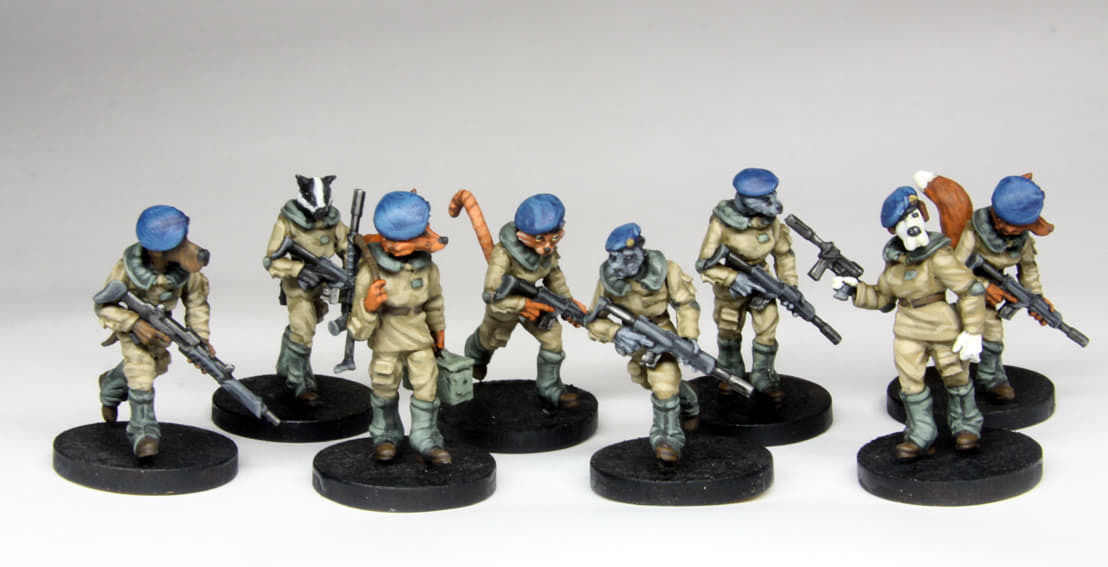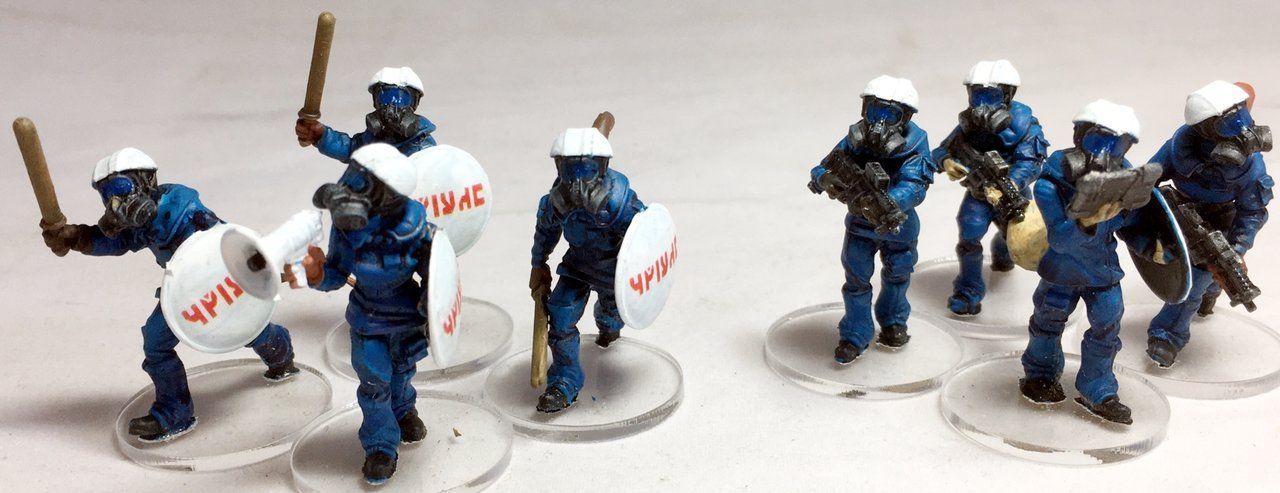
Welcome to this, the third in my series on building a basic ACP army. Today we will look at HomeGuard units, which, you will recall from the first post in this series are stood up by individual systems using “a grab bag of equipment and forces that suit their needs.” This happens often in the real world. Look at Finland, which had a strict policy of buying equal amounts of kit from NATO and Eastern Bloc suppliers. Many countries change their supplier based on politics and who will sell to them.
Now, the more astute of you may well be saying… wait. “The picture above just shows EDF critters with different hats!” Well, you’re not wrong. Not being endowed with massive budgets, we took a design decision early on that the best way to differentiate between HomeGuard units was simply to change the hats and paint the miniatures a different colours. But that’s a good thing on balance, because it let us add a new faction very cheaply – in fact, because of the customisability, it’s actually a range of different factions.
The units described below are from the Almata Campaign book that was released as part of the original range, which I recommend you should totally buy if you want a ready made Home Guard Order of Battle – except for the AFVs which have not yet been released…
Building a HomeGuard Army
The first design decision is really what sort of system your HomeGuard is defending. In the sourcebooks we describe a few systems, with their planets, and of course the Almata campaign is set on a desert planet. There’s not a lot of canon in the Albedo Universe, so you can really invent to your heart’s delight.
The choice you make at this point, will affect the sort of unit you want to build. I suggest that there are five basic questions you need to ask and answer. They are:
- What is the predominant terrain on the home planet?
- Is the system aligned to a particular faction?
- Is the system populated more by a particular species?
- How strong is the local economy?
- What era is the force you are building for?
Let’s look at these in order.
Terrain
Terrain is a basic determinator of the kind of force you build. Ocean planet? Desert? Jungle? Asteroid Belt? There are some examples on page 28 of the sourcebook to spark your imagination.
Using the Almata example, the desert terrain means that AFVs are not only possible, but almost essential. It also gave me the opportunity to specify tanks, even though I’ve not designed them yet. Hmm. In terms of outfit, the hat of choie is the Kepi, as per the French Foreign Legion. Very cool. You can see that the police critters in the picture below have the Kepi heads, and there’s also an officer model without the neck protection.

Political Affiliation
If the system is aligned to the ConFed, then it follows that ConFed standard weapons and equipment might be favoured. Conversely, ILR aligned systems might have wheeled APC as standard. When designing the Almata HomeGuard (AHG), I reflected that system’s neutrality with a mix of equipment from both sides.
Species Specificity
The Almata system was first populated by Penguins. (Anyone who thinks that Penguins are not scary should really look inside their mouths… but I digress.) So, I could have specified only penguin troopers for the Almata HomeGuard (AHG) but since they don’t carry guns that might be a bit reductive. To get over that, I made sure that Almata had a good mix of species represented, as explained on page 12.

Ethnic Groups: Almata was originally settled by
Penguins, and many remain, although they find the
hot climate disagreeable.
Generally, the system population reflects the
ethnic breakdown of the ConFed, with a tendency
to favour arid climate dwellers. For example, Foxes
are likely to be Fennecs, and Felines are more likely
to be Lions.
There is a high and growing proportion of rabbits
(currently around 30%) many of whom have
migrated here as refugees from the expanding ILR
sphere of influence.
Economics
Force design usually reflects the amount of money available (to you, and to the system…) Poor systems have light infantry and improvised vehicles. Very rich ones can afford Aerodynes and AirMobile units.
Era
In the first post in this series we talked about the Era you plan to play in. The historical date you play in affects the weapons fit and organisation, so it’s important. The sourcebook contains sample organisations for all eras, and you can also download these charts for free from the web store. Here’s the AHG Orbat, for example.
A sample unit – AHG Police Squad
To illustrate the sort of flexibility you can have with HomeGuard units, here is a sample from the AHG 4th Battalion.
4th Battalion is the part of the AHG that is responsible for keeping the peace. They do this in the normal ways you’d expect of a police force, in terms of Detectoring, Patrolling, Riot control and arresting the usual suspects. In designing this force, I thought about how you might organise to meet these needs, and came up with this:

There are lots of vehicles to play with, including some scope for improvisation, since we don’t have any civilian vehicles in the range (yet). In keeping with the system neutrality, the APC is ILR Pattern, but the sidearms and outfits are EDF pattern.
There’s lots of scope for individuality here. The detectors and 8 Company tend to operate in plain clothes. (Don’t ask about 8 Company.) For these units, I’d use Civilian figures, modified with suitable weapon arms from the conversion range if necessary. There are lots of enterprising companies who make 28mm models of civilian cars, and I’d either find some of those, or design my own.
You can easily make a Police Squad using the figures shown in the headline picture to this article. The Area Support Squad is basically Riot Police, and there’s a pack for that too. I really like these guys, who look really scary with their gas masks and billy clubs. It’s worth poiting out that the ACP rules variant contains rules for all sorts of non-lethal weaponry, making police actions a viable gaming opportunity.

Vehicles again
This sort of organisation is really suitable for eras 2,3, and 4 with no modification, and would benefit from the addition of a suitable vehicle. So that’s why we’re planning to release that medium truck new year, with STL download and print on demand options. If there is sufficient demand, there might be a run of resin vehicles as well.

Summary
Once again, I’ve used this article to talk about the HomeGuard, and dived into how I designed a specific unit. This topic is realy as broad as it’s long, and in later posts, I’ll look at some different HomeGuard formations and how they might look in ACP164.
Until next time!

Based on real world examples, on worlds conquered by the ILR, do you think locally raised security units (from carefully vetted Lapine volunteers) could be fielded alongside Garrison Infantry units?
I think they would find it very difficult to avoid being volunteered and pressed into service. In that case, they would be the HomeGuard faction, perhaps.